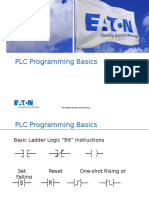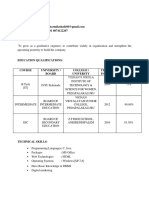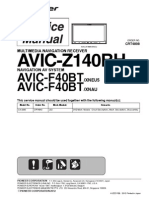Assignment - PLC Programming
Uploaded by
Srinivas ShareAssignment - PLC Programming
Uploaded by
Srinivas ShareHLC. BTEC.
Assessment Center Number 024150
Course: BTEC Extended Diploma in Student:
Manufacturing Engineering / Diploma in
Electrical / Electronic Engineering
Unit/s:
Unit 25: Selection & Application of Programmable Logic Controllers
Outcome/s: (2) Produce a PLC program
Grading criteria:
P3 Use a programmable technique to produce, store and present a program that demonstrates the
full range of instruction types.
P4 Explain the program documentation that has been used for a complex engineering application.
M2 Justify the choice of a specific programming method and the methods used to produce, store
and present the program.
D1 Evaluate program documentation used to control an automated machine/process and make
recommendations for improvement.
D2 Compare the current capabilities and limitations of a programmable controller and identify
possible areas of future development.
Pass: Merit: Distinction:
Instructions:
• Attempt all questions
• Work to be word processed, legible and succinct, with an adequate grasp
of grammar, punctuation and spelling
• Ensure sketches & diagrams are clear, accurate & labelled
• True graphs, titled & axes labelled
• List sources where appropriate.
Student feedback:
Student declaration – The assignment attached is my own work.
Signed: Date:
Assessor feedback:
Signed: Date:
Internal verification Issue date Student hand in date Internal verification
(Before issue) (assessment decision)
CR 10/9/11
TUTOR R.A.KERSHAW.
Unit 25: Selection and Application of Programmable Logic Controllers Page 1 of 6
Assignment - PLC Programming.docx
HLC. BTEC. Assessment Center Number 024150
Grading Criteria and Feedback
P3 Use a programmable technique to produce, store and present a
program that demonstrates the full range of instruction types.
P4 Explain the program documentation that has been used for a complex
engineering application.
M2 Justify the choice of a specific programming method and the
methods used to produce, store and present the program.
D1 Evaluate program documentation used to control an automated
machine/process and make recommendations for improvement.
D2 Compare the current capabilities and limitations of a programmable
controller and identify possible areas of future development.
Unit 25: Selection and Application of Programmable Logic Controllers Page 2 of 6
Assignment - PLC Programming.docx
HLC. BTEC. Assessment Center Number 024150
Assignment - PLC Programming
This practical and written assignment provides evidence for satisfaction of
the Grading Criteria P3 and P4, and the opportunity to achieve M2, D1 and D2.
Using your class notes, the Bytronic Ladsim PLC application and any other
suitable resource, attempt all of the following tasks. (The relevant learning
outcome is given in brackets after each task)
Programming Tasks
You are to design and produce PLC program for the Bytronic Industrial Control
Trainer (ICT), as described in the Ladsim manual available on the course wiki.
The purpose of the machine is to sort two components, a metal body with a
peg and a plastic ring. The ring is assembled on to the peg and the finished
assembly is inspected with components not assembled being rejected.
The programming task details five independent tasks that are need to make
the machine work. You should design, develop and test each program
separately and then combine then into a single program.
Unit 25: Selection and Application of Programmable Logic Controllers Page 3 of 6
Assignment - PLC Programming.docx
HLC. BTEC. Assessment Center Number 024150
Evidence Required
a. Either a flowchart, truth table, or logic functional block diagram for
each section, which ever is the most suitable for that section (at least
one example of each must be produced)
b. A complete ladder program with comments, to be demonstrated to your
tutor
c. A hard copy of your complete program. This is to include the ladder
and statement versions plus the comments
Input / Output Definitions
Inputs
Label Name Non-detection state
IP0 Metal Peg Detect Low
IP1 Sort Area Low
IP2 Hopper Full Low
IP3 Ring Assembled High
IP4 Component Detect High
IP5 Reject Area Low
IP6 Start Low
IP7 Stop High
IP8 Belt Peg Detect Low
Outputs
Label Name
OP0 Chain Motor (upper conveyor motor)
OP1 Sort Solenoid (ejects rings into chute)
OP2 Rotary Solenoid (allows rings in to hopper)
OP3 Reject Solenoid (ejects faulty components)
OP4 Belt Motor (lower conveyor motor)
Program 1 – Start & Stop
Use the Start and Stop buttons IP6 and IP7 to activate and deactivate both
the chain conveyor OP0, and the belt conveyor OP4.
Unit 25: Selection and Application of Programmable Logic Controllers Page 4 of 6
Assignment - PLC Programming.docx
HLC. BTEC. Assessment Center Number 024150
Program 2 – Sorting
Use the Metal Peg Detect IP0 and Sort Area IP1 sensors at the sorting area
to determine the identity of the item and by activating the Sort Solenoid OP1,
sort the rings into the ring chute. Pegs should be allowed to pass, enabling
them to continue down onto the belt conveyor.
Program 3 – Assembly Chute
Use a counter to record the number of
rings in the chute: when full (5 rings in
queue), no further rings should be added.
Activate the Rotary Solenoid OP2 to
dispense rings into the assembly hopper
when the Hopper Full sensor IP2
indicates that it is empty.
Program 4 – Inspection
Use the Belt Peg Detect sensor IP8 and
the Ring Assembled sensor IP3 to
determine whether the component is a
correctly assembled part.
If the components are not assembled
correctly then a flag may be used to
register this for later use in the reject
area.
Use the Component Detect sensor IP4 to detect anything passing out of the
assembly area.
Unit 25: Selection and Application of Programmable Logic Controllers Page 5 of 6
Assignment - PLC Programming.docx
HLC. BTEC. Assessment Center Number 024150
Program 5 – Rejection
Use the Reject Area sensor IP5 to detect when a part is at the reject area
and determine from the data captured previously whether the component
needs to be accepted or rejected (i.e. it’s a ring or a peg on its own). Operate
the Reject Solenoid OP3 to knock the rejected components off the conveyor.
(P3, P4)
Written Tasks
1. Flowcharts, Truth tables and logic function diagrams are used to design
PLC programs. Briefly explain the advantages and disadvantages of each
method; you may give examples where one method might be more useful
than another.
(M2)
2. Define the meaning of the terms “offline” and “online” programming in
relation to PLCs, and discuss the advantages and disadvantages of both
methods.
(M2, D2)
3. Discuss the methods used to debug PLC programs and explain the
usefulness and limitations of each method.
(D1, D2)
4. When a program is transferred from a PC to a PLC or a programming panel
is used to transfer the program, you are given an option to compare your
program after transfer. Explain what this means and why it is important.
(D1)
Unit 25: Selection and Application of Programmable Logic Controllers Page 6 of 6
Assignment - PLC Programming.docx
You might also like
- Large Batching Control Application: Workshop#3: Design of HMI Applications For Process Monitoring100% (3)Large Batching Control Application: Workshop#3: Design of HMI Applications For Process Monitoring6 pages
- Chapter 8: PLC Programming Language - Basic InstructionsNo ratings yetChapter 8: PLC Programming Language - Basic Instructions57 pages
- ETEN4001 SUP PLC Exercises 1 With Solutions100% (2)ETEN4001 SUP PLC Exercises 1 With Solutions5 pages
- Plcapplicationslides 140202052211 Phpapp02100% (1)Plcapplicationslides 140202052211 Phpapp0293 pages
- Programmable Logic Controller (PLC) : Abhishek SoniNo ratings yetProgrammable Logic Controller (PLC) : Abhishek Soni36 pages
- Design of Electrical Circuits using Engineering Software ToolsFrom EverandDesign of Electrical Circuits using Engineering Software ToolsNo ratings yet
- Higher National Diploma in Engineering: Assessment BriefNo ratings yetHigher National Diploma in Engineering: Assessment Brief4 pages
- Shaik .Sharmila Email Id Contact No: +91 8074122207 Career ObjectiveNo ratings yetShaik .Sharmila Email Id Contact No: +91 8074122207 Career Objective2 pages
- Excusable Delays Are Delays That Are Unforeseeable and Beyond The Control of The ContractorNo ratings yetExcusable Delays Are Delays That Are Unforeseeable and Beyond The Control of The Contractor1 page
- Installation Instruction Sheet - 36kV 630A TNo ratings yetInstallation Instruction Sheet - 36kV 630A T8 pages
- Service Manual Lexmark X264 - X363 - X364 - 7013No ratings yetService Manual Lexmark X264 - X363 - X364 - 7013244 pages
- Questions 1 State The Quality Problems Incurred During The Extended ServiceNo ratings yetQuestions 1 State The Quality Problems Incurred During The Extended Service2 pages
- Term Project: Simulation of Different Protocols Using Cnet Network SimulatorNo ratings yetTerm Project: Simulation of Different Protocols Using Cnet Network Simulator14 pages
- MIX-M501MAP Monitor Module: Installation and Maintenance InstructionsNo ratings yetMIX-M501MAP Monitor Module: Installation and Maintenance Instructions1 page
- Reversal Automation: System Access InformationNo ratings yetReversal Automation: System Access Information6 pages
- Don Bosco Technical College: SY 2023-24 Mechanical Engineering Program 1 - Semester College Department Meelec 1No ratings yetDon Bosco Technical College: SY 2023-24 Mechanical Engineering Program 1 - Semester College Department Meelec 117 pages
- Move and Selection Tools: Polygonal Lasso ToolNo ratings yetMove and Selection Tools: Polygonal Lasso Tool5 pages
- Manual. MOVIDRIVE MDX61B Sensor Based Positioning Via Bus Application. Edition 01 - 2005 FA362000 11313528 - ENNo ratings yetManual. MOVIDRIVE MDX61B Sensor Based Positioning Via Bus Application. Edition 01 - 2005 FA362000 11313528 - EN84 pages
- Categorizing Traditional Chinese Painting Images: Lecture Notes in Computer Science October 2004No ratings yetCategorizing Traditional Chinese Painting Images: Lecture Notes in Computer Science October 20049 pages
- Large Batching Control Application: Workshop#3: Design of HMI Applications For Process MonitoringLarge Batching Control Application: Workshop#3: Design of HMI Applications For Process Monitoring
- Chapter 8: PLC Programming Language - Basic InstructionsChapter 8: PLC Programming Language - Basic Instructions
- Programmable Logic Controller (PLC) : Abhishek SoniProgrammable Logic Controller (PLC) : Abhishek Soni
- Design of Electrical Circuits using Engineering Software ToolsFrom EverandDesign of Electrical Circuits using Engineering Software Tools
- Higher National Diploma in Engineering: Assessment BriefHigher National Diploma in Engineering: Assessment Brief
- Shaik .Sharmila Email Id Contact No: +91 8074122207 Career ObjectiveShaik .Sharmila Email Id Contact No: +91 8074122207 Career Objective
- Excusable Delays Are Delays That Are Unforeseeable and Beyond The Control of The ContractorExcusable Delays Are Delays That Are Unforeseeable and Beyond The Control of The Contractor
- Questions 1 State The Quality Problems Incurred During The Extended ServiceQuestions 1 State The Quality Problems Incurred During The Extended Service
- Term Project: Simulation of Different Protocols Using Cnet Network SimulatorTerm Project: Simulation of Different Protocols Using Cnet Network Simulator
- MIX-M501MAP Monitor Module: Installation and Maintenance InstructionsMIX-M501MAP Monitor Module: Installation and Maintenance Instructions
- Don Bosco Technical College: SY 2023-24 Mechanical Engineering Program 1 - Semester College Department Meelec 1Don Bosco Technical College: SY 2023-24 Mechanical Engineering Program 1 - Semester College Department Meelec 1
- Manual. MOVIDRIVE MDX61B Sensor Based Positioning Via Bus Application. Edition 01 - 2005 FA362000 11313528 - ENManual. MOVIDRIVE MDX61B Sensor Based Positioning Via Bus Application. Edition 01 - 2005 FA362000 11313528 - EN
- Categorizing Traditional Chinese Painting Images: Lecture Notes in Computer Science October 2004Categorizing Traditional Chinese Painting Images: Lecture Notes in Computer Science October 2004

































































































